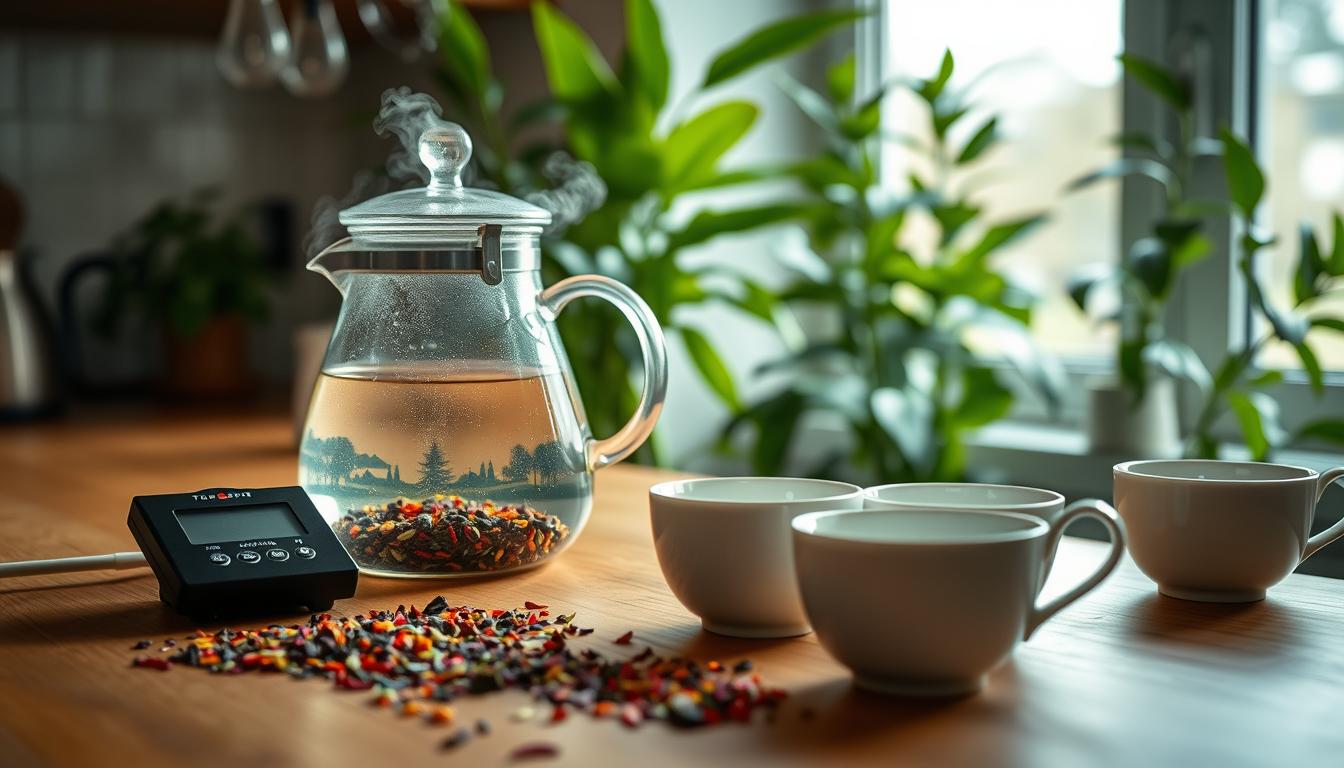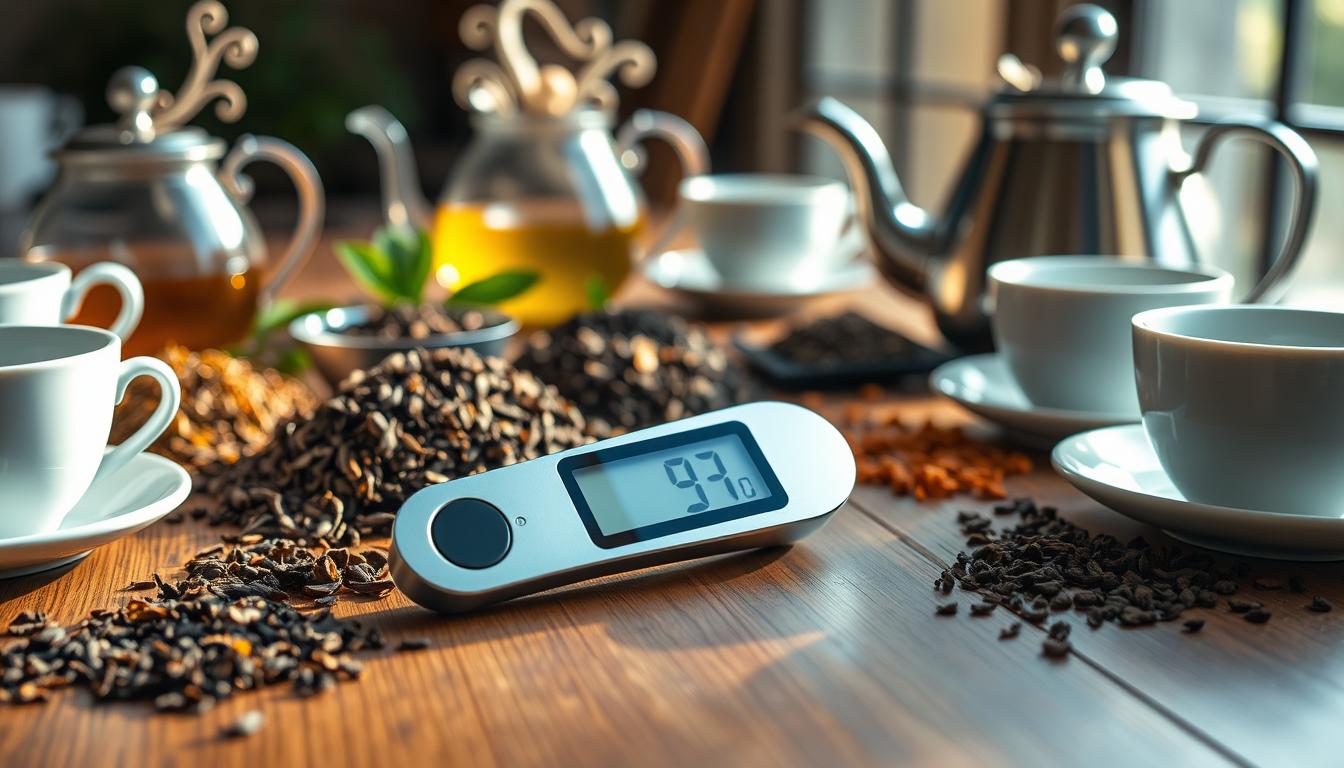Did you know 75% of tea lovers don’t know the best temperature for their tea? This can lead to a less-than-perfect cup. As someone who loves tea, you know how important it is to get it right. The right tools, like a tea thermometer, can make a huge difference.
A tea thermometer is key for the perfect flavor and aroma. It ensures your water is at the right temperature. This is essential for any serious tea lover looking to improve their brewing skills.
Key Takeaways
- Using a tea thermometer ensures the optimal temperature for brewing tea
- Temperature control is crucial for bringing out the unique flavors and aromas of different tea types
- A tea thermometer is an essential tea accessory for any serious tea enthusiast
- Investing in a tea thermometer can significantly improve the overall tea-brewing experience
- With a tea thermometer, you can experiment with various tea types and flavors with confidence
- A tea thermometer helps to prevent overheating or underheating, which can ruin the perfect cup of tea
The Importance of Temperature in Tea Brewing
Temperature control is key when brewing tea. The right temperature varies by tea type. Black tea needs boiling water, while green tea prefers cooler water to avoid bitterness. Temperature control brings out each tea’s unique flavor, and a tea thermometer is a must-have for tea lovers.
To brew the perfect tea, knowing the ideal temperatures is crucial. Here are some guidelines:
- Black tea: 200-212°F (93-100°C)
- Green tea: 160-170°F (71-77°C)
- White tea: 150-160°F (65-71°C)
- Oolong tea: 180-200°F (82-93°C)
Using a tea thermometer helps you control water temperature precisely. This ensures your tea is always perfect. Whether you love strong black tea or delicate green tea, tea brewing is an art that requires attention to detail. Mastering temperature control lets you enjoy the perfect cup every time, with flavors and aromas that match your taste.

In conclusion, controlling temperature is essential in tea brewing. A tea thermometer is the best tool to ensure your tea is brewed just right. By knowing the ideal temperatures for each tea and using a thermometer, you can always have the perfect cup. This is the secret to enjoying tea with the perfect flavor and aroma, thanks to temperature control and tea brewing.
| Tea Type | Ideal Temperature |
|---|---|
| Black tea | 200-212°F (93-100°C) |
| Green tea | 160-170°F (71-77°C) |
| White tea | 150-160°F (65-71°C) |
| Oolong tea | 180-200°F (82-93°C) |
How a Tea Thermometer Can Improve Your Tea Brewing
Using a tea thermometer can make your tea brewing better by controlling the temperature. This ensures your water is at the best temperature for your tea. This results in a more flavorful and aromatic cup. With a tea thermometer, you can try different temperatures and brewing times to find your favorite tea.
Some key benefits of using a tea thermometer include:
- Improved flavor and aroma: The right temperature brings out the tea’s unique qualities.
- Increased consistency: It helps you get the same great results every time.
- Enhanced experimentation: Precise temperature control lets you explore different brewing methods.
Temperature control is key in tea brewing. Different teas need specific temperatures to reveal their flavors and aromas. A tea thermometer makes it easy to get the perfect temperature for black, green, or herbal teas. By using a tea thermometer, you can elevate your tea brewing and enjoy a more satisfying cup.

A tea thermometer is a must-have for tea lovers. It provides the precision needed to brew the perfect cup of tea. With it, you can explore new flavors and aromas in tea brewing.
| Tea Type | Optimal Temperature |
|---|---|
| Black Tea | 200-212°F (93-100°C) |
| Green Tea | 160-170°F (71-77°C) |
| Herbal Tea | 212°F (100°C) |
Types of Tea Thermometers
There are many types of tea thermometers to choose from. Each has its own special features and benefits. You can find digital, analog, and infrared tea thermometers.
Tea lovers have a variety of thermometers to pick from. Digital thermometers give precise readings, which many tea fans prefer. Analog thermometers, however, offer a more classic feel.
Digital vs. Analog Thermometers
Digital thermometers are known for their accuracy and simplicity. They give quick and precise readings, perfect for those who need exact temperatures. Analog thermometers, while less precise, have a traditional charm that some enjoy.
Infrared Tea Thermometers
Infrared tea thermometers measure water temperature using infrared radiation. They are quick and easy to use, making them great for those who value convenience. These thermometers are often pricier but offer unique benefits.
Smart Tea Thermometers
Smart tea thermometers connect to your phone or tablet. They let you track temperature and brewing time easily. They come with features like temperature tracking and brewing guides, making them perfect for tech-savvy tea lovers.
| Thermometer Type | Features | Benefits |
|---|---|---|
| Digital Thermometers | Precise temperature readings, ease of use | Accuracy, convenience |
| Analog Thermometers | Traditional and tactile experience | Aesthetic appeal, simplicity |
| Infrared Tea Thermometers | Quick and convenient temperature measurement | Convenience, ease of use |
| Smart Tea Thermometers | Temperature tracking, brewing guides, customizable settings | Technology, convenience, precision |
How to Choose the Right Tea Thermometer
Choosing the right tea thermometer involves several important factors. Look for accuracy, ease of use, and material and durability. A good thermometer should give precise temperature readings. It should also have a range that fits your tea brewing needs and be simple to read and use.
The material and durability of the thermometer are key. It should be able to handle regular use and cleaning. Opt for a thermometer made from high-quality, corrosion-resistant materials that can handle extreme temperatures.
Key Considerations
- Accuracy: Look for a tea thermometer with high accuracy, typically +/- 0.5°C or +/- 1°F.
- Ease of use: Choose a tea thermometer with a clear and easy-to-read display, and simple operation.
- Material and durability: Select a tea thermometer made from durable materials, such as stainless steel or silicone.
By focusing on these factors, you can find a tea thermometer that meets your needs. It will help you brew the perfect cup of tea every time. Whether it’s green tea, black tea, or herbal tea, the right thermometer ensures the perfect temperature.
Comparison of Tea Thermometer Types
| Tea Thermometer Type | Accuracy | Ease of Use | Material and Durability |
|---|---|---|---|
| Digital Tea Thermometer | High accuracy, +/- 0.5°C or +/- 1°F | Easy to read and operate | Durable materials, such as stainless steel or silicone |
| Analog Tea Thermometer | Lower accuracy, +/- 1-2°C or +/- 2-4°F | Less easy to read and operate | Less durable materials, such as plastic or glass |
How to Use a Tea Thermometer
Using a tea thermometer is key to perfect tea brewing. To use it well, start by calibrating it as the maker suggests. This ensures your temperature readings are spot on, which is vital for great tea.
Then, put the thermometer in the water and wait for it to settle. This might take a few minutes. But it’s worth it to get your tea brewed just right. For instance, black tea needs about 200°F, while green tea is best at 170°F. A thermometer helps you hit these temperatures, making your tea taste better and smell more aromatic.
Here are some extra tips for using a tea thermometer:
- Always clean and maintain your thermometer regularly to prevent any buildup or damage.
- Use your thermometer to monitor the temperature of your tea as it steeps, adjusting the brewing time as needed.
- Experiment with different temperatures to find the perfect balance for your favorite type of tea.
By following these simple steps and using a tea thermometer, you can elevate your tea brewing. Enjoy the perfect cup of tea every time.
| Tea Type | Optimal Temperature | Brewing Time |
|---|---|---|
| Black Tea | 200°F | 3-5 minutes |
| Green Tea | 170°F | 2-3 minutes |
| Herbal Tea | 212°F | 5-7 minutes |
Conclusion
A tea thermometer is a must-have for tea lovers. It helps you make the perfect cup of tea every time. This is true for any type of tea you like.
Whether you’re new to tea or have been drinking it for years, a tea thermometer makes a big difference. It keeps the temperature just right and brings out the best flavors. It’s a key tool for anyone who loves brewing tea.
Ready to make your tea even better? Get a good tea thermometer. It will help you enjoy every sip of your tea, making it more flavorful and aromatic.

